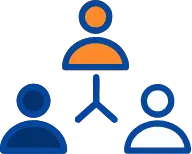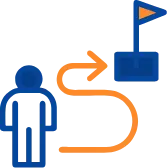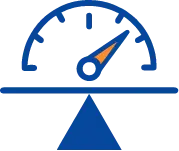Talent Management
"You gotta build a team that is so talented, they almost make you uncomfortable."
- Brian Chesky
PeopleWiz's Talent Management portfolio comprises of a set of integrated organizational HR processes designed to attract, develop, motivate, and retain productive, engaged employees.

Competency Modeling
Finding the right fit for the right job is a matter of concern for most organizations. In competency-based HR processes, both the employer and the employee benefit by establishing a transparent blueprint for recruitment, job expectations, performance evaluation, and career advancement paths.

Assessment & Development Centre
PeopleWiz Assessment & Development Centre method includes an exhaustive list of options covering the entire gamut of Leadership Competency Definition, Leadership Competency Level Identification, Leadership Development Planning and Leadership Capability Development & Program Management. While we will design a customized Leadership Competency Assessment Tools for our clients, our approach will keep in consideration long term impact and usage of the competency model towards building the desired competencies across various levels of the organization.

Continuous Performance Management (CPM)
CPM is an approach that fosters continuous conversations between managers, direct reports, and teams about goals, work progress, and performance to date (in the form of constructive or positive feedback). It typically includes on-going one-on-one conversations between managers and direct reports, periodic performance / development conversations, and continuous, real-time collection of performance feedback data from employees' networks. In other words, CPM is all about Employee enablement through continuous feedback.

OKR (Objective & Key Results)
OKR is a framework for defining and tracking objectives and their outcomes. It's a way for an individual, a team or a company to stay focused and work towards important objectives.
Used by companies like Google, Linkedin, Atlassian and many other tech startups, what Agile has done for managing software projects, OKR has the potential to realize for managing goal setting and achievement.
| Concept | Description |
|---|---|
| Agile Goals | Instead of using annual static planning, OKR takes an agile approach. By using shorter goal cycles, companies can adapt and respond to change. |
| Simplicity | Using OKR is straightforward, and the OKRs themselves are easy to understand.Companies that adopt OKR reduce the time spent setting goals from months to days. |
| Transparency | The primary purpose of OKR is to create alignment in the organization. To do so, OKRs are public to all company levels - everyone has access to everyone else's OKRs. The CEO's OKRs usually are available on the Intranet. |
| Nested Cadences | Strategy and tactics have different natural tempos since the latter tends to change much faster. To solve this, OKR adopts different rhythms:
|
| Bidirectional Goal Setting | Instead of using the traditional top-down cascading model, OKR uses an approach that is simultaneously bottom-up and top-down.
From the company's strategic OKRs, teams can understand how they can contribute to the overall strategy. In this process, around 60% of the tactical OKRs are set by the teams in alignment with the company goals and then contracted with the managers in a bubble-up approach. |

Balanced Scorecard (BSC) & Key Performance Indicators (KPIs)
The Balanced Scorecard is a proven performance measurement system. It is a comprehensive strategic performance management system and methodology. It is a framework for defining, refining and communicating strategy, for translating strategy to operational terms, and for measuring the effectiveness of strategy implementation.
| Perspective | Key Question |
|---|---|
| Financial | To succeed financially, how should we appear to our stakeholders? |
| Customer | To achieve our vision, how should we appear to our customers? |
| Process | To satisfy our customers and shareholders, at what business processes must we excel? |
| Learning and Growth | To achieve our vision, how will we sustain our ability to change and improve? |

Compensation & Reward Strategy
Keeping in line with the changing environment , compensation systems need to be designed in such a way that they are aligned to the business goals and strategies. If you want to maintain an edge over your competitors and succeed in this increasingly competitive environment you must have a well-designed compensation plan that motivates employees, controls compensation costs, and ensures equity.
Our Clients Love Us
CARE Group has embarked on a transformational journey and HR & Culture are the most important elements. We needed partners that could truly understand us and our needs. PeopleWiz were probably the best we could have chosen. They helped us take some deep transformational steps, which needed careful calibration and insights. The diverse team applied perspective of business, HR, and finance to build effective solutions while matching the swift pace of the assignment. Highly recommended for business aligned and people focused consulting!

MD & CEO |
CARE Ratings Ltd
We chose PeopleWiz when we were looking for niche expertise in the area of Organization Design. The team adopted a rigorous approach to building recommendations. They took efforts to understand Quick Heal and also brought unique insights from the industry. Their openness, concern for clients and participative approach has been truly appreciated at Quick Heal. We would highly recommend PeopleWiz to anyone looking for a partner who will not just deliver but also care.

CEO | Quick Heal Pvt Ltd
I find in PeopleWiz, a dedicated partner, who spares no effort to understand my challenges and requirement. They are conscious about quality, open to feedback and flexible in their approach. I have found them always ready to support and work as one of our own. It has been a pleasure working with them.

Head Development Tech & Ops R&D, APAC |
Syngenta Asia Pacific Pte Ltd
PeopleWiz worked with our Systems Integration Business, to articulate the vision, build consensus on business goals and recommend an Organization design that gets us ready for the future. The business appreciation, industry insight and concern for satisfying the customer with quality work makes PeopleWiz stand apart.

Business Head |
Sterlite Technologies
In PeopleWiz, we found the HR partners who invested time and efforts in understanding our Organization, its mission, our HR philosophy and strategy before coming out with recommendations that were not only practical, realistic and beneficial to both management and employees, but also were benchmarked to best practices.

Founder Director |
Venture Center
We have been collaborating with PeopleWiz to deliver projects globally to our clients supporting them with advisory services covering a range of topics on Organization Design, Performance Management, People Policy creation and other People Management Processes. The team has brought in deep expertise across all areas and has always stepped up to the occasion managing tight deadlines, and unique client requirements. We greatly admire their keenness to explore new sectors and look forward to a continued and fruitful partnership.

Lead Partner, Global Digital Delivery |
KPISoft Technologies Pvt Ltd
With ConnectWise expanding its base in India through acquisitions, we were looking out for knowledgeable HR partners who would help us in ensuring local compliance as well as cultural integration. With PeopleWiz, we have found the right mix of HR expertise, commitment and ownership. It has been a pleasure partnering with PeopleWiz and we would highly recommend them for anyone who need a committed HR partner while making a foray in the Indian markets.

PHR, Generalist |
ConnectWise, LLC
A knowledgeable team of consultants, PeopleWiz produced deliverables that were well researched, realistic and easy to use. I found them to be methodical, flexible in their approach and open to ideas. They have created a meaningful repository of work that will be useful for our future developmental work.

Global Head Human Resources |
Geometric Ltd
A great team to work with, PeopleWiz consultants show consistently high level of energy, inspiring and motivating the management and employees alike. It has been a pleasure to associate with them.

Co-Founder & Director |
Neologic Engineers Pvt Ltd
PeopleWiz team has displayed high level ownership and concern for Neologic’s benefit. Throughout the design and deployment of the new structure. Our continued engagement with them is a testament to the confidence and trust that they have rightfully earned.

Co-Founder & Director |
Neologic Engineers Pvt Ltd
Delivering the future of workplace